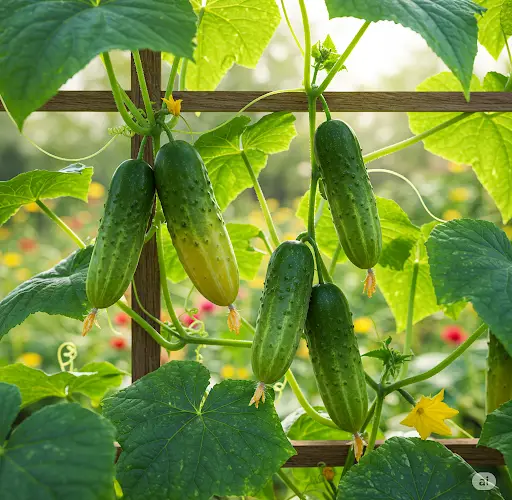Cucumbers are among the most rewarding vegetables to grow in a home garden. With their fast growth, generous yields, and refreshing taste, they’re a staple in both summer salads and pickling jars. But if you’re finding that your cucumber harvest is limited — with sparse fruits or small yields — there may be a simple solution.
By slightly changing how you cultivate your cucumbers, you can dramatically boost your harvest. Gardeners using this method have reported yields up to 10 times greater per plant, with healthier vines, more blooms, and longer fruiting periods.
Here’s how you can transform your cucumber growing results with this smart, proven technique.
The Key to High-Yield Cucumbers: Correct Plant Training and Care
The secret to a bountiful cucumber harvest lies in proper vertical training, timely pruning, and nutrient support. This method is not only space-saving but also improves airflow, reduces disease, and channels the plant’s energy where it matters most — into fruit production.
Step 1: Choose the Right Variety
Start with a high-yielding, disease-resistant cucumber variety. Parthenocarpic hybrids (which do not require pollination to set fruit) are excellent for greenhouses and small spaces. For open ground, choose outdoor-pollinated varieties that are known for long-term productivity.
Look for varieties labeled as:
-
High-yield or prolific
-
Resistant to powdery mildew or downy mildew
-
Compact vines for small spaces or long vines for trellising
Step 2: Provide Vertical Support
Cucumbers thrive when grown vertically. Installing a trellis, netting, or vertical wire system helps vines climb and keeps fruit off the ground, where it’s more likely to rot or be damaged by pests.
Benefits of vertical growing include:
-
Better sunlight exposure
-
Improved airflow, reducing fungal disease
-
Easier harvesting
-
Space-saving — ideal for small gardens
Trellising also allows the plant to focus its energy on fruit production rather than sprawling vine growth.
Step 3: Prune Strategically for More Fruit
Cucumbers are naturally vigorous, but too many side shoots and leaves can waste the plant’s resources. Here’s how to prune for maximum yield:
-
Remove the lower 3–4 side shoots and leaves to create airflow at the base.
-
Pinch off all lateral shoots up to 50–60 cm (20–24 inches) from the base of the main stem.
-
Above that point, allow 1–2 fruits per node, but prune extra side shoots as they appear.
-
After the plant reaches the top of the trellis, pinch the growing tip to direct energy to fruit development instead of more vine length.
This pruning method encourages the plant to produce more flowers and fruit along the main stem and upper nodes, where light is strongest.
Step 4: Use the Right Feeding Strategy
To get heavy cucumber production, the plant needs a steady supply of nutrients. Follow this simple fertilization schedule:
-
After planting: Enrich the soil with compost and a balanced organic fertilizer (NPK 10-10-10 or similar).
-
During flowering: Use a phosphorus- and potassium-rich feed (like liquid compost tea, banana peel water, or a commercial bloom booster).
-
Every 10–14 days: Apply a mild foliar spray of calcium and magnesium (or diluted wood ash tea) to strengthen the vines and prevent blossom-end rot.
Organic mulches (like straw or grass clippings) help retain moisture, regulate soil temperature, and feed the soil as they decompose.
Step 5: Watering Makes or Breaks the Yield
Cucumbers are 95% water — inconsistent watering can lead to bitter fruits, poor fruit set, or misshapen cucumbers.
-
Water deeply 2–3 times per week.
-
Keep the soil consistently moist but never soggy.
-
Avoid overhead watering to prevent mildew — water at the base.
Mulching around the base will also reduce water loss and suppress weeds.
Step 6: Harvest Regularly
The more often you harvest cucumbers, the more the plant produces. Leaving overripe fruits on the vine signals the plant to stop producing new ones.
-
Pick cucumbers every 2–3 days at their ideal size.
-
Use scissors or a knife to avoid damaging the stem.
Regular harvesting keeps the plant in a continuous cycle of flowering and fruiting.
Final Thoughts
By combining vertical support, smart pruning, and nutrient management, you can increase cucumber yields dramatically — even up to 10 times more per plant compared to standard methods.
This method works in garden beds, containers, and greenhouses alike. Whether you’re growing cucumbers for your kitchen, your market stall, or just the joy of gardening, this approach will help you make the most of every plant.
Start with one or two vines, apply these tips, and watch your cucumber harvest take off — not just in quantity, but in size and flavor as well.



